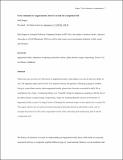From Animation to Augmentation: Dennō Coil and the Composited Self
Author(s)
Roquet, Paul
DownloadMain article (11.98Mb)
OPEN_ACCESS_POLICY
Open Access Policy
Creative Commons Attribution-Noncommercial-Share Alike
Terms of use
Metadata
Show full item recordAbstract
When cities are covered over with layers of augmented reality, what shadows are cast by this new ability to see? The Japanese anime series Dennō Coil explores exactly this question, following a group of children living in a near-future society where augmented reality glasses have become as essential to daily life as smartphones have today. Comparing debates over ‘seamful’ design in ubiquitous computing with the role of the alpha channel in digital image compositing, the author argues for understanding the sensory environments of augmented reality as part of a longer history of bringing the animated image out into the spaces of everyday life. This article explores the new physical and psychological demands placed on individuals as they seek to navigate the protocols of this newly augmented world, while cultivating and conditioning what the author calls the ‘composited self’.
Keywords: alpha channel, animation, anime, augmented reality, childhood, Dennō Coil, image compositing, Iso Mitsuo, ubiquitous computing
Date issued
2016-10Department
Massachusetts Institute of Technology. Global Languages; Massachusetts Institute of Technology. Program in Comparative Media Studies/WritingJournal
Animation
Publisher
Sage Publications
Citation
Roquet, Paul. “From Animation to Augmentation: Dennō Coil and the Composited Self.” Animation 11, 3 (November 2016): 228–245 © 2016 SAGE Publications
Version: Author's final manuscript
ISSN
1746-8477
1746-8485